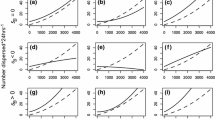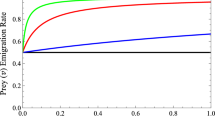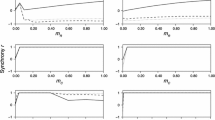Conclusion
The model examples in this paper illustrate that non-random spatial distributions of predation or parasitism by polyphagous natural enemies will not necessarily promote population persistence. The test of whether such responses are stabilizing requires the spatial distribution of predation to be examined over a range of total prey densities. As shown in Fig. 2, a contribution to stability will occur if average predation from each spatial response tends to be positively related to total prey density.
Similar content being viewed by others
References
Chesson PL, Murdoch WW (1986) Aggregation of risk: relationships among host-parasitoid models. Am Nat 127:696–715
Beddington JR, Free CA, Lawton JH (1978) Modelling biological control: on the characteristics of successful natural enemies. Nature 273:513–519
Hassell MP (1978) The Dynamics of Arthropod Predator-Prey Systems. Princeton University Press, Princeton
Hassell MP (1982) Pattern of parasitism by insect parasitoids in patchy environments. Ecol Entomol 7:365–377
Hassell MP, May RM (1973) Stability in insect host-parasite models. J Anim Ecol 442:693–726
Hassell MP, May RM (1974) Aggregation in predators and insect parasites and its effect on stability. J Anim Ecol 43:567–594
Hassell MP, May RM (1986) Generalist and specialist natural enemies in insect predator-prey interactions. J Anim Ecol 55:923–940
Hassell MP, May RM (1988) Spatial heterogeneity and the dynamics of parasitoid-host systems. Ann Zool Fenn 25:55–61
Hassell MP, Southwood TRE, Reader PM (1987) The dynamics of the virburnum whitefly (Aleurotrachelus jelinekhii (Fraunf.)): a case study on population regulation. J Anim Ecol 56:283–300
Lawton JH, McNeill S (1979) Between the devil and the deep blue sea: on the problem of being a herbivore. In: Anderson RM, Turner BD, Taylor LR (eds.) Population dynamics. Symposium of the British Ecological Society, 20, pp. 223–244
Lessells CM (1985) Parasitoid foraging: should parasitism be density dependent? J Anim Ecol 54:27–41
Murdoch WW (1977) Stabilizing effects of spatial heterogeneity in predator-prey systems. Theor Pop Biol 11:252–273
Murdoch WW, Oaten A (1975) Predation and population stability. Adv Ecol Res 9:1–131
Shorrocks B, Rosewell J (1986) Guild size in drosophila: a simulation model. J Anim Ecol 55:527–542
Stiling PD (1987) The frequency of density dependence in insect host-parasitoid systems. Ecology 68:844–856
Taylor LR, Woiwod IP, Perry JN (1979) The negative binomial as a dynamic ecological model for aggregation, and the density dependence of k. J Anim Ecol 48:289–304
Author information
Authors and Affiliations
Rights and permissions
About this article
Cite this article
Latto, J., Hassell, M.P. Generalist predators and the importance of spatial density dependence. Oecologia 77, 375–377 (1988). https://doi.org/10.1007/BF00378045
Received:
Issue Date:
DOI: https://doi.org/10.1007/BF00378045




